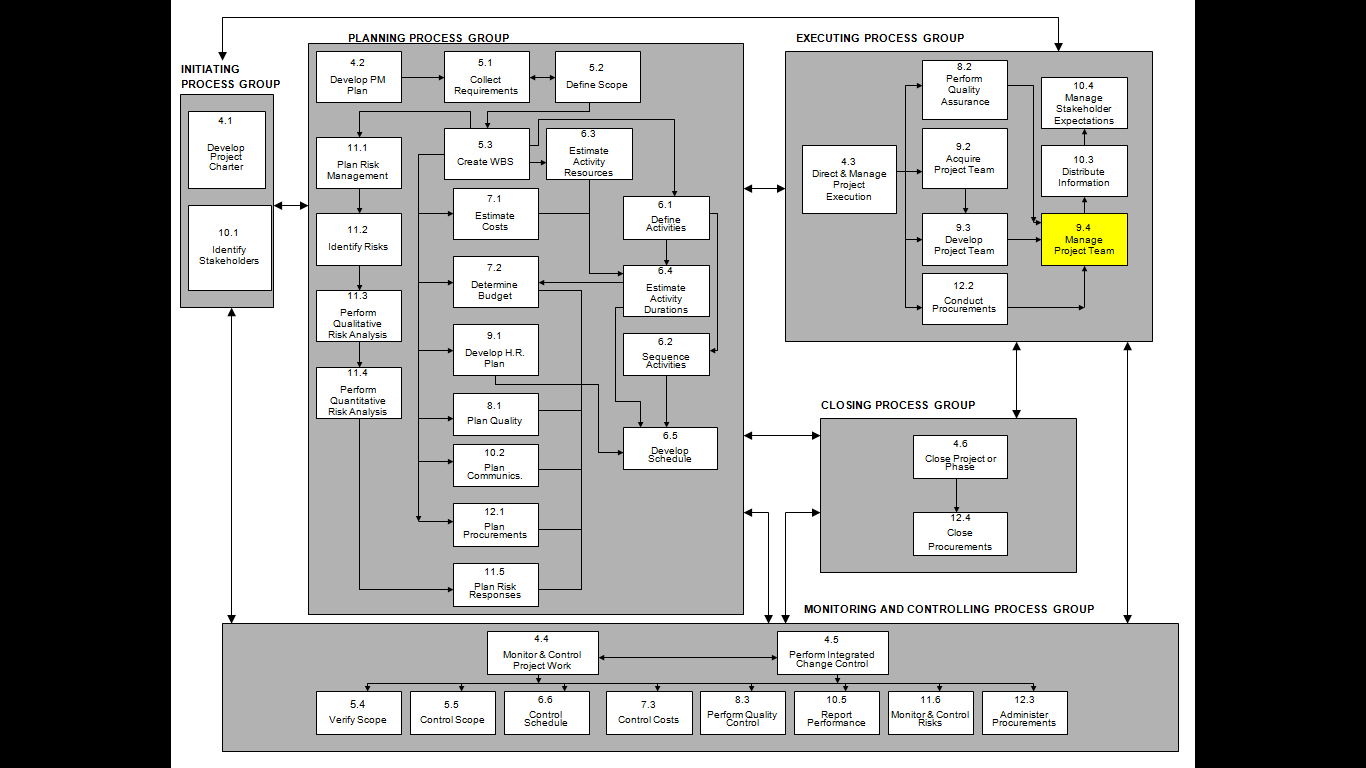With excerpts from my Project Management Novel, I will illustrate the many processes of the PMBOK. Here is the eighth one: Estimate Activity Resources. Use this map to see how this process fits into the scheme of processes.

Now that the men were no longer grumbling about their gambling losses, Gwilym expected lifted spirits. While this was true the first few days, pretty soon fights between the team-members seemed to get even worse, and some had to be broken up by Gwilym. They were arguing about the different activities they were supposed to be doing. Gwilym surmised that removing Tarrant as a common enemy had surfaced these rivalries. He called a team meeting.
“Gentlemen! We are all working together to build a grand structure. We know what we have to do and how we are to do it. What are we arguing about?”
“’E’s supposed to ’ook the stones to the foundation afore Oi can build on ’em but ’e won’t do it!” accused one of the men, pointing at another.
“Oo said that were moi job?” retorted the one accused.
“You’re the lead mason, of course it’s your job!” replied the first.
More men started pointing fingers at others and a general uproar ensued. Gwilym listened for a few minutes and then he stood. He said nothing, but those looking at him quieted down and those not, noticing that others had quieted, looked around and shut up at seeing Gwilym. Finally only one pair of men was left arguing.
“You keep throwin’ your stone scraps off to the side instead of bringin’ them to me for moi road!”
“Well oi’m not yer bloody servant! Get the scraps yerself!” At that the two men noticed Gwilym looking at them and felt the eyes of the rest of the men. They both blushed and quieted down.
Gwilym thought for a moment and then spoke. “Do we agree that this book shows the way the tower should be built?” Reluctant nods of heads affirmed this.
“It tells us WHY, WHERE, HOW we are building it and WHAT we are building, right?” More heads nodded.
“But what it doesn’t tell us is WHO does what, right?”
This question was greeted with enthusiastic agreement; all the men shouting over each other how this question of WHO did WHAT was affecting their work.
“All right then, nobody does any more work today until we figure it out.”
Gwilym placed the project book in the center of the table and opened it to the defined activities and pointed to the first one. “This activity is done. See how I’ve placed a check mark next to it?” The men nodded.
“So are all these activities.” He showed a series of activities accompanied by check marks. “Here is the next activity that must be done. One of you must do it. It says, ‘Level foundation.’ Who in this room will take responsibility for that activity?”
No one said a word. The men had been used to not volunteering for work since that had always meant more work for them at the same pay.
“I need two things for every activity: some materials and somebody to do something with those materials. Both are resources. What I’m trying to do now is estimate resources needed to complete each activity. And for that I need you to step up and take responsibility that you will be that resource.”
Gwilym looked hard at Joseph. “Isn’t that your job, Joseph?”
“Aye, it be moi job a’roit. But ain’t it your ’sponsibility?”
“The entire project is my responsibility. But I cannot be responsible for all of these activities. I’m not a master foundation builder like you, Joseph. You know when it is level and strong. You’re the one who told us we had to add piles into the river and add more rock to make it strong. So I ask again, who is responsible for leveling the foundation?”
“That be me,” Joseph admitted.
“Then I will write your name next to that activity. Is that alright?”
“Aye”
“Good. The next activity says: ‘Create notch templates.’ That’s my responsibility so I’ll place my name next to that activity.” Gwilym signed his name.
“Now then, the next activity says: ‘Cut first logs to length.’ Who is responsible for that?” Gwilym looked around and noticed something interesting. The men who had appeared scared at volunteering for work when he asked of the first activity were looking around at each other, focusing on Peter, the lead carpenter, placing peer pressure on him to volunteer.
Peter felt their looks and raised his hand. “That’s moi activity.”
“How about, ‘Cut notches in first layer of logs’?”
“Oi’ll give that activity to moi apprentice, Fergus,” replied Peter.
Gwilym was about to write Fergus’ name on the plan when he had an idea. He liked the fact that men were volunteering for activities. He felt that this would give him pressure that he could apply when it came time to do the activity. They had made a commitment in front of their peers to do something. If they were just told in front of others that they were responsible, they could always say that they hadn’t wanted the responsibility. But now, by volunteering, they were telling everyone that they would do it.
Gwilym turned to Fergus, “Do you agree to take on this activity?”
Fergus looked to Peter, then back at Gwilym. “Oi’ll take responsibility, sirrah.”
The men laughed but shut up when they saw that Gwilym was serious. He wrote Fergus next to this activity and moved to the one after it. The team went through each activity, one at a time until each one had a person’s name next to it.
There were a few hitches. Some activities had to be better defined. Gwilym readily did this, realizing that they would have had problems with these activities when they got to that point anyway; better to plan it properly today. Some activities were duplicated and they were removed.
There was an activity where two men wanted responsibility. ‘Place cornerstone of tower on arch.’ Joseph, the master arch builder wanted to be certain this was placed in the correct location but so did William, the tower man. In this case, Gwilym broke the activity into two activities and each man took responsibility for one of them. One activity read, ‘Decide location of center of tower’ and Joseph took this activity. The other activity read, ‘Place cornerstone based on arch center’ and William took this activity.
There was an activity nobody wanted that anyone could do. ‘Book room for celebration.’ Gwilym watched all the men looking around at each other, no-one willing to take on this small, extra activity. He looked at the plan and noticed that one of the laborers had not taken responsibility for any activities; the rest had taken at least one. “Hal, could you take this one on?” he asked. Hal looked embarrassed and agreed.
The last hiccough in this operation was one activity that nobody wanted. All refused to meet Gwilym’s eye as he read the activity and looked at his men. He repeated the activity and asked his men what the problem was.
“‘Place arch supports’ is an activity that is always a problem,” he was told. “Men who do that never try it again. There are too many problems with it. You always get the arch builders complaining that the supports are too high or too low or not strong enough. The last three men I know who did that, two I never heard from them again and the third is Barry here, he talks to himself and is only good for simple laboring jobs.”
This last statement elicited a roar of laughter at which the confused Barry smiled. The men then calmed down and looked to Gwilym for guidance. “This reminds me of people not wanting to take charge of a tough project. So let’s treat it like a small project. What is the first part of this activity?”
Gwilym took a blank sheet of parchment and wrote on the top, ‘Place arch supports’. The men offered suggestions on activities below this: ‘Measure depth of water’, ‘Hammer pilings into river’, ‘Create support foundation’, ‘Draw out support structure’, ‘Get agreement on support structure’, Measure wood’, ‘Place supports’, ‘Attach cross braces’, and so on. When they had offered up all the work packages, Gwilym asked for a responsible person for each work package. The men stalled again on ‘Get agreement on support structure’ so Gwilym offered to break this work package down even further. But then Joseph agreed to take on this work package and the team continued on planning the project.
It took the rest of the day but Gwilym, looking around at the expressions of his men, was convinced that this exercise was worth it. The activities were better defined; the men had a clear idea of what their responsibility was on this project. They also understood what the other men were tasked with and developed a respect for each other’s workload.
Gwilym spent the next day rewriting the project plan to include these new activities and the person responsible for each. He used his finest calligraphy to place the names of the responsible men next to the activities with illuminated capital letters. Then he showed these to the men who were proud to see their names so honored. Because of the different colored inks and the clear, illuminated capital letters, each man could clearly see the activities for which they had taken responsibility.
This was the document Gwilym walked around with for the rest of the project, checking off each activity as it was completed. He then went to the next man and reminded him of the activity he had volunteered for and asked him to start working on it.







